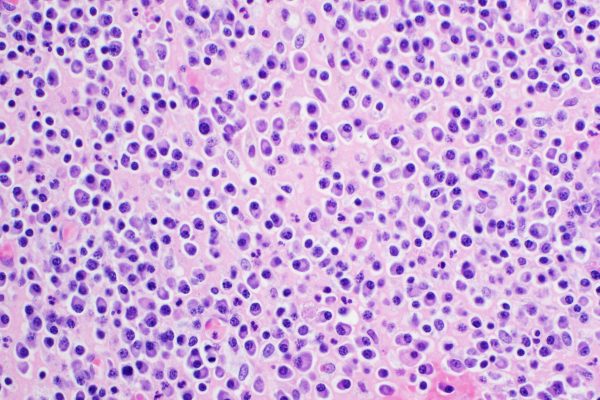
Data from the phase II PANORAMA-3 trial suggest that a subcutaneous administration of bortezomib improves the tolerability of the panobinostat-bortezomib-dexamethasone triplet in patients with relapsed/refractory multiple myeloma (RRMM). In this trial, three different doses of panobinostat were tested of which the 20 mg three or two times weekly were associated with the highest response rate. In contrast, panobinostat at a dose of 10 mg three times per week was best tolerated.

Over the last decade we have witnessed an explosion in the number of therapeutic options available to patients with multiple myeloma (MM). In spite of the marked improvements in patient outcomes paralleling these approvals, MM remains an incurable malignancy for the vast majority of patients following a course of therapeutic successes and failures. As such, there remains a dire need to develop new tools to improve the management of MM patients. Optimization of a dosing regimen is one of the many tools. The phase II PANORAMA-3 trial provides further evidence of the efficacy of the combination of oral panobinostat and dexamethasone plus bortezomib subcutaneously.
Despite the impressive progress that was made in the treatment of patients with relapsed refractory multiple myeloma (RRMM), there is a continued need for novel therapeutic options that can overcome resistance and produce durable responses with enhanced tolerability.1 Histone deacetylase inhibitors (HDI), such as panobinostat, previously demonstrated clinical efficacy in combination with bortezomib and dexamethasone; with the ability of restoring responses in patients who are refractory to bortezomib.2,3 Currently, the combination of panobinostat with bortezomib and dexamethasone is registered in the US and Europe for the treatment of RRMM patients who received ≥2 previous lines of therapy, including bortezomib and an immunomodulatory agent.4,5 This registration is based on a subgroup analysis of the pivotal phase 3 PANORAMA 1 trial.6
A study reported by Moreau, et al later demonstrated that intravenous (iv) bortezomib administration is associated with a higher incidence of peripheral neuropathy and gastrointestinal toxicity compared to a subcutaneous (sc) administration.7 Optimisation of the dosing regimen of panobinostat plus bortezomib plus dexamethasone to reduce overlapping toxicities might prolong treatment duration and, in turn, improve patient outcomes. In this respect, the randomised phase II PANORAMA 3 trial was designed to evaluate the efficacy and safety of three different dosing regimens of oral panobinostat, in combination with sc bortezomib and oral dexamethasone.8 The study enrolled 248 patients with RRMM and randomly assigned (1:1:1) them to receive oral panobinostat 20 mg three times weekly, 20 mg twice weekly, or 10 mg three times weekly, plus sc bortezomib and oral dexamethasone. The primary endpoint was overall response rate (ORR) after up to eight treatment cycles.
After a median follow-up of 14.7 months, the ORR was reported at 62.2% for the 20 mg three times weekly group, 65.1% for the 20 mg twice-weekly group, and 50.6% for the 10 mg three times weekly group. PFS and OS will be analysed when all patients have completed treatment (by 2024–25). In a posthoc subgroup analysis, the ORR in the panobinostat 20 mg three times weekly group was similar in patients aged ≤75 years and in patients aged >75 years (62.5% vs. 60.0%). In the other two groups, the ORR was higher in patients aged ≤75 years. The regimen with the highest dose and frequency of panobinostat administration had the greatest efficacy but this came at the cost of a modest increase in grade ≥3 adverse events.
The most common AEs reported included diarrhoea, thrombocytopenia, anaemia, nausea, fatigue, neutropenia, and asthenia (all mainly grade 1–2).6 Notably, the incidence of grade ≥3 thrombocytopenia and diarrhoea decreased from cycle 5 onwards, likely due to a corresponding decrease in bortezomib dosing frequency. Grade ≥3 AEs occurred in 91% of patients in the 20 mg times 3 group, in 83% in the 20 mg times 2 group, and 75% in the 10 mg times 3 group (most commonly thrombocytopenia and neutropenia). The incidence of AEs, including diarrhoea, with the approved dose of panobinostat was lower than what was observed with the same dosing regimen including iv bortezomib. The reported ORR in this study is similar what was seen in PANORAMA 1.6 As such, the use of subcutaneous bortezomib seems to improve tolerability with similar patient outcome.
To summarize,this study provides further evidence of the efficacy of the combination of oral panobinostat and dexamethasone plus bortezomib sc in this setting. Although there was greater toxicity associated with the higher dose of panobinostat, the safety profile was favourable compared with previous studies, and antitumor activity was preserved.8 Future studies should focus on comparison of the treatment groups and further defining toxicity.
References